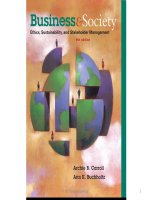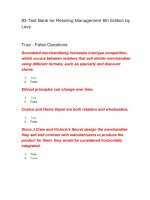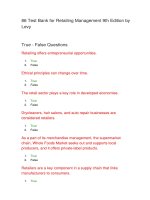Lecture Retailing management (6/e): Chapter 18 - Levy Weitz
Bạn đang xem bản rút gọn của tài liệu. Xem và tải ngay bản đầy đủ của tài liệu tại đây (1.44 MB, 37 trang )
Chapter 18
Store Layout, Design and
Visual Merchandising
McGrawHill/Irwin
Retailing Management, 6/e
Copyright © 2007 by The McGrawHill Companies, Inc. All rights reserved.
18-
Store Management
Customer Service
2
Managing the Store
Layout, Design and
Visual Merchandising
REI’s Store Environment
183
Store Design Objectives
•
•
•
•
•
Implement retailer’s strategy
Influence customer buying behavior
Control design and maintenance costs
Provide flexibility
Meet legal requirements
184
185
Store Design
The primary objective of store design is implementing the retailer’s strategy
(c) Brand X Pictures/PunchStock
Meets needs of target market
Builds a sustainable competitive advantage
Displays the store’s image
C. Borland/PhotoLink/Getty Images
18-
Impact on Customer Behavior
•
•
•
•
•
Attract customers to store
Enable them to easily locate merchandise
Keep them in the store for a long time
Motivate them to make unplanned purchases
Provide them with a satisfying shopping
experience
H. Wiesenhofer/PhotoLink/Getty Images
6
18-
Today’s Demographics
7
Time limited families are spending less time planning
shopping trips and making more decisions in the
stores.
Retailers can:
Advertise
Package products differently
Research the “first moment of truth”
Royalty-Free/CORBIS
18-
Tradeoff in Store Design
Royalty-Free/CORBIS
(c) image100/PunchStock
Ease of locating
merchandise for
planned purchases
8
Exploration of
store, impulse
purchases
18-
Legal Considerations
9
Americans with Disabilities Act (ADA)
Protects people with disabilities from discrimination in
employment, transportation, public accommodations,
telecommunications and activities of state and local
government
Affects store design as disabled people need “reasonable
access” to merchandise and services built before 1993. After
1993, stores are expected to be fully accessible.
Reasonable Access
1810
What does that mean?
• 32 inch wide pathways on the
main aisle and to the
bathroom, fitting rooms
elevators and around most
fixtures
• Lower most cash wraps and
fixtures so they can be
reached by a person in a
wheelchair
• Make bathroom and fitting
room fully accessible
Keith Brofsky/Getty Images
Types of Store Layouts
Grid
Racetrack
Free Form
1811
18-
Grid Layout
12
• Long gondolas in repetitive pattern.
• Easy to locate merchandise
• Does not encourage customers to
explore store
– Limited site lines to merchandise
• Allows more merchandise to be displayed
• Cost efficient
• Used in grocery, discount, and drug
stores. Why?
The McGraw-Hill Companies, Inc./Andrew Resek, photographer
1813
Receiving & storage
Grid Store Layout
Fruit
Vegetables
Books, magazines, seasonal
display
Checkouts
Cart
area
Entrance
Office &
customer
service
Exit
18-
Racetrack Layout
14
• Loop with a major aisle that has access
to departments and store’s multiple
entrances.
• Draws customers around the store.
• Provide different site lines and encourage
exploration, impulse buying
• Used in department stores
18-
JCPenney Racetrack Layout
15
18-
Example of Race Track Layout
PhotoLink/Getty Images
16
18-
Free-Form (Boutique) Layout
• Fixtures and aisles arranged
asymmetrically
• Pleasant relaxing ambiance
doesn’t come cheap – small store
experience
• Inefficient use of space
• More susceptible to shoplifting –
salespeople can not view
adjacent spaces.
• Used in specialty stores and
upscale department stores
17
Jack Star/PhotoLink/Getty Images
1818
Free-Form Layout
Pants
Clearance
Items
Feature
Open Display Window
Tops
Tops
Accessories
Checkout counter
Feature
Open Display Window
Hats and Handbags
Dressing Rooms
Underwear
Skirts and Dresses
Jeans
Casual Wear
Stockings
Storage, Receiving, Marketing
Michael Evans/Life File/Getty Images
18-
Example of Boutique Area
19
18-
Usage of Signage and Graphics
20
• Locational – identifies location of merchandise and guides
customers
• Category Signage – identifies types of products and located
near the goods
• Promotional Signage – relates to specific offers – sometimes in
windows
• Point of sale – near merchandise with prices and product
information
• Lifestyle images – creates moods that encourage customers to
shop
18-
Effectively Using Signage
•
•
•
•
•
•
21
Coordinate signage to store’s image
Use appropriate type faces on signs
Inform customers
Use them as props
Keep them fresh
Limit text
Rim Light/PhotoLink/Getty Images
18-
Digital Signage
•
•
•
•
•
•
22
Visual Content delivered digitally through a centrally
managed and controlled network and displayed on a TV
monitor or flat panel screen
Superior in attracting attention
Enhances store environment
Provides appealing atmosphere
Overcomes time-to-message hurdle
Messages can target demographics
Eliminates costs with printing, distribution and installing
traditional signage
Feature Areas
1823
Feature areas
– End caps
– Promotional aisle
– Freestanding
displays
– Cash wraps
– Walls
– Windows
PhotoLink/Getty Images
18-
Space Planning
24
• Productivity of allocated space
• Merchandise inventory turnover
• Impact on store sales
Photodisc/Getty Images
• Display needs for the merchandise
Space Planning Considerations
1825
• Profitability of merchandise
• Customer Buying considerations
– Impulse products near front
– Demand/Destination areas off the beaten path
• Physical characteristics of product.
• Complementary products should be adjacent
• Sales rate
– More units of faster selling merchandise need to be
displayed









